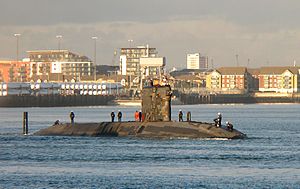 HMS Trafalgar, 2008
| |
| History | |
|---|---|
| Name | HMS Trafalgar |
| Namesake | Battle of Trafalgar |
| Ordered | 7 April 1977 |
| Builder | Vickers Shipbuilding and Engineering, Barrow-in-Furness |
| Laid down | 15 April 1979 |
| Launched | 1 July 1981 |
| Commissioned | 27 May 1983 |
| Decommissioned | 4 December 2009 |
| Homeport | HMNB Devonport, Plymouth |
| Fate | Awaiting Disposal |
| Badge |  |
| General characteristics [1] | |
| Class and type | Trafalgar-class submarine |
| Displacement | |
| Length | 85.4 m (280 ft)[2] |
| Beam | 9.8 m (32 ft)[2] |
| Draught | 9.5 m (31 ft)[2] |
| Propulsion |
|
| Speed | Over 30 knots (56 km/h), submerged[2] |
| Range | Unlimited[2] |
| Complement | 130[2] |
| Electronic warfare & decoys |
|
| Armament | |
| Service record | |
| Operations: | Operation Veritas (Afghanistan) |
HMS Trafalgar is a decommissioned Trafalgar-class submarine of the Royal Navy. Unlike the rest of the Trafalgar-class boats that followed, she was not launched with a pump-jet propulsion system, but with a conventional 7-bladed propeller.[3] Trafalgar was the fifth vessel of the Royal Navy to bear the name, after the 1805 Battle of Trafalgar.
- ^ Jane's Fighting Ships, 2004-2005. Jane's Information Group Limited. p. 796. ISBN 0-7106-2623-1.
- ^ a b c d e f g h Bush, Steve (2014). British Warships and Auxiliaries. Maritime Books. p. 12. ISBN 978-1904459552.
- ^ a b Graham, Ian, Attack Submarine, Gloucester Publishing, Oct 1989, page 12. ISBN 978-0-531-17156-1